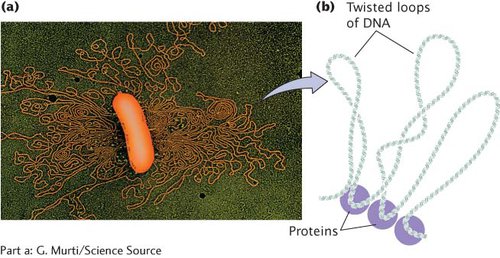The Bacterial Chromosome
Most bacterial genomes consist of a single circular DNA molecule, although linear DNA molecules have been found in a few species. In circular bacterial chromosomes, the DNA does not exist in an open, relaxed circle; the 3 million to 4 million base pairs of DNA found in a typical bacterial genome would be much too large in this state to fit into a bacterial cell (see Figure 8.15). Bacterial DNA is not attached to histone proteins as is eukaryotic DNA (considered later in this chapter), but bacterial DNA is associated with a number of proteins that help to compact it.
When a bacterial cell is viewed with an electron microscope, its DNA frequently appears as a distinct clump, called the nucleoid, which is confined to a definite region of the cytoplasm. If a bacterial cell is broken open gently, its DNA spills out in a series of twisted loops (Figure 8.17a). The ends of the loops are most likely held in place by proteins (Figure 8.17b). Many bacteria contain additional DNA in the form of small circular molecules called plasmids, which replicate independently of the chromosome (see Chapter 7).

CONCEPTS
A typical bacterial chromosome consists of a large circular molecule of DNA that forms a series of twisted loops. Bacterial DNA appears as a distinct clump, the nucleoid, within the bacterial cell.
 CONCEPT CHECK 8
CONCEPT CHECK 8
How does bacterial DNA differ from eukaryotic DNA?
Bacterial DNA is not complexed with histone proteins and is circular.